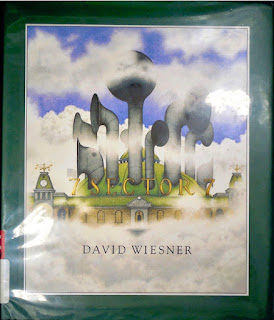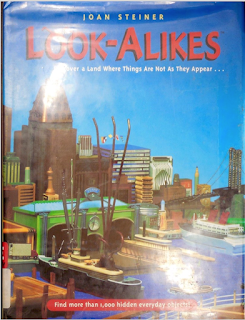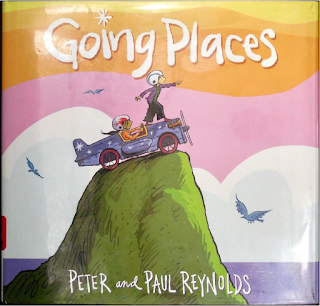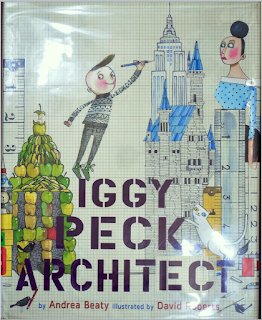5 Picture Books That Capture the Nature of Creativity
If you want to explain to kids what creativity is all about,
here are 5 picture books you might like to discuss with them.
Art points to transcendancy
In David Wiesner’s wordless picture book, Sector 7, a boy and his class go to visit the Empire State Building and view the city. But it’s foggy: there is nothing to see when they get to the observation deck.
So the boy plays a trick of the imagination and makes the fog a creature/friend. Boy and foggy friend go off on an adventure to a mysterious place in the sky called Sector 7 where the boy redesigns the clouds, turning them into the shapes of fish and other sea creatures.

The story transforms a foggy, disappointing day into an magical adventure and reminds us that art helps us transcend the mundane.
The book also reminds us that a perfectly “real” picture may not be the most interesting kind of picture.
Teachers might like to use the story when a child complains that his/her art doesn't look real/right. Sometimes looking “beyond right” is better than looking right.
Art and creativity bring order out of chaos.
Art is one way we make sense of what goes on around us. We take what we see and ORGANIZE it to make sense of it. The boy in Sector 7 starts in a confusing fog and creates order - he transforms amorphous clouds into nameable objects.
One way we begin to make order is by letting two planes of thought intersect. An example of that kind of activity - connecting seemingly unrelated things - can be found in the Look-Alikes books.

You’ll find stacks of CD covers that look like high-rises, nut-crackers that transform into bridges, and boat masts made out of compasses. Soon you’ll being seeing all kinds of connections between what you ordinarily see and other things that they may remind you of: two planes of thought will be intersecting!
Creativity requires reflection and evaluation.
After we (1) connect ideas to create a new idea, we need to (2) test its value.
In the book Going Places, notice how both of these skills:
-
Letting two planes of thought intersect, and
-
Testing the value of a new idea
are used as two kids build their go-cart.

The teacher announces a competition called Going Places. Every kid gets a go-cart and all the go-cart kits are the same. But Maya, instead of using the kit as it is, glances up at a bird and lets two planes of thought intersect - a go-cart and a bird.
She makes a trial version and joins up with her neighbor, Rafael, who takes charge of evaluation. Together they make a go-cart that flies. Of course, THIS is the go-cart that wins the race.
Art and creativity require total involvement.
In order to be creative, we need to get lost in our work. We’ve all experienced this phenomenon. We’re so involved in an activity that we forget the time. We forget to eat.
Likewise, we do creative work because we WANT to. Others can’t make us be creative. A perfect illustration of this is the book Art.

Drawing is all Art wants to do. Art is so involved in his art we are left wondering, “Can you tell them apart?”
And as this book reminds us, an adult cheer-leader is also a great spur to a child's creativity. A little bit later Art sees his art on the refrigerator, “Held there by magnets (stars and a heart), put there by mother, ‘cause mother loves Art.”
Art and creativity are NOT self-indulgence.
You have probably met those creative types who use creativity as an excuse for self-indulgence. Creativity, however, is not meant for self-indulgence, nor is it first of all for one’s own pleasure. The goal of creativity is the service of others.
Iggy Peck is “an architect, and has been since he was two.”

All goes fine for Iggy until he gets to grade two, and his teacher bans any discussion of architecture.
But when the class goes on a hike and arrives on an island, the bridge they have just used collapses.
The class is doomed until Iggy collects everyone’s shoelaces and builds a bridge that saves the day. Creativity isn’t about self-indulgence. It’s about service.
Art and creativity are practical.
Last of all, art and creativity are practical skills. That may come as a surprise, because - just think about it - in order to be creative,
-
We have to waste time,
-
We work in silence,
-
So that we can bring order out of the seeming chaos of our lives.
It seems like craziness.
But there is an increasing call for creative people.
IBM recently asked CEO’s around the world what were the top qualities they sought when hiring someone. The answer? “The ability to deal with complexity.” When asked what qualities they found lacking in today’s workplace, they said “creativity.”
Give your students a chance to practice creativity with free art lessons here.
If you want to explain to kids what creativity is all about,
here are 5 picture books you might like to discuss with them.
Art points to transcendancy
In David Wiesner’s wordless picture book, Sector 7, a boy and his class go to visit the Empire State Building and view the city. But it’s foggy: there is nothing to see when they get to the observation deck.
So the boy plays a trick of the imagination and makes the fog a creature/friend. Boy and foggy friend go off on an adventure to a mysterious place in the sky called Sector 7 where the boy redesigns the clouds, turning them into the shapes of fish and other sea creatures.

The story transforms a foggy, disappointing day into an magical adventure and reminds us that art helps us transcend the mundane.
The book also reminds us that a perfectly “real” picture may not be the most interesting kind of picture.
Teachers might like to use the story when a child complains that his/her art doesn't look real/right. Sometimes looking “beyond right” is better than looking right.
Art and creativity bring order out of chaos.
Art is one way we make sense of what goes on around us. We take what we see and ORGANIZE it to make sense of it. The boy in Sector 7 starts in a confusing fog and creates order - he transforms amorphous clouds into nameable objects.
One way we begin to make order is by letting two planes of thought intersect. An example of that kind of activity - connecting seemingly unrelated things - can be found in the Look-Alikes books.

You’ll find stacks of CD covers that look like high-rises, nut-crackers that transform into bridges, and boat masts made out of compasses. Soon you’ll being seeing all kinds of connections between what you ordinarily see and other things that they may remind you of: two planes of thought will be intersecting!
Creativity requires reflection and evaluation.
After we (1) connect ideas to create a new idea, we need to (2) test its value.
In the book Going Places, notice how both of these skills:
-
Letting two planes of thought intersect, and
-
Testing the value of a new idea
are used as two kids build their go-cart.

The teacher announces a competition called Going Places. Every kid gets a go-cart and all the go-cart kits are the same. But Maya, instead of using the kit as it is, glances up at a bird and lets two planes of thought intersect - a go-cart and a bird.
She makes a trial version and joins up with her neighbor, Rafael, who takes charge of evaluation. Together they make a go-cart that flies. Of course, THIS is the go-cart that wins the race.
Art and creativity require total involvement.
In order to be creative, we need to get lost in our work. We’ve all experienced this phenomenon. We’re so involved in an activity that we forget the time. We forget to eat.
Likewise, we do creative work because we WANT to. Others can’t make us be creative. A perfect illustration of this is the book Art.

Drawing is all Art wants to do. Art is so involved in his art we are left wondering, “Can you tell them apart?”
And as this book reminds us, an adult cheer-leader is also a great spur to a child's creativity. A little bit later Art sees his art on the refrigerator, “Held there by magnets (stars and a heart), put there by mother, ‘cause mother loves Art.”
Art and creativity are NOT self-indulgence.
You have probably met those creative types who use creativity as an excuse for self-indulgence. Creativity, however, is not meant for self-indulgence, nor is it first of all for one’s own pleasure. The goal of creativity is the service of others.
Iggy Peck is “an architect, and has been since he was two.”

All goes fine for Iggy until he gets to grade two, and his teacher bans any discussion of architecture.
But when the class goes on a hike and arrives on an island, the bridge they have just used collapses.
The class is doomed until Iggy collects everyone’s shoelaces and builds a bridge that saves the day. Creativity isn’t about self-indulgence. It’s about service.
Art and creativity are practical.
Last of all, art and creativity are practical skills. That may come as a surprise, because - just think about it - in order to be creative,
-
We have to waste time,
-
We work in silence,
-
So that we can bring order out of the seeming chaos of our lives.
It seems like craziness.
But there is an increasing call for creative people.
IBM recently asked CEO’s around the world what were the top qualities they sought when hiring someone. The answer? “The ability to deal with complexity.” When asked what qualities they found lacking in today’s workplace, they said “creativity.”
Give your students a chance to practice creativity with free art lessons here.
If you want to explain to kids what creativity is all about,
here are 5 picture books you might like to discuss with them.
Art points to transcendancy
In David Wiesner’s wordless picture book, Sector 7, a boy and his class go to visit the Empire State Building and view the city. But it’s foggy: there is nothing to see when they get to the observation deck.
So the boy plays a trick of the imagination and makes the fog a creature/friend. Boy and foggy friend go off on an adventure to a mysterious place in the sky called Sector 7 where the boy redesigns the clouds, turning them into the shapes of fish and other sea creatures.

The story transforms a foggy, disappointing day into an magical adventure and reminds us that art helps us transcend the mundane.
The book also reminds us that a perfectly “real” picture may not be the most interesting kind of picture.
Teachers might like to use the story when a child complains that his/her art doesn't look real/right. Sometimes looking “beyond right” is better than looking right.
Art and creativity bring order out of chaos.
Art is one way we make sense of what goes on around us. We take what we see and ORGANIZE it to make sense of it. The boy in Sector 7 starts in a confusing fog and creates order - he transforms amorphous clouds into nameable objects.
One way we begin to make order is by letting two planes of thought intersect. An example of that kind of activity - connecting seemingly unrelated things - can be found in the Look-Alikes books.

You’ll find stacks of CD covers that look like high-rises, nut-crackers that transform into bridges, and boat masts made out of compasses. Soon you’ll being seeing all kinds of connections between what you ordinarily see and other things that they may remind you of: two planes of thought will be intersecting!
Creativity requires reflection and evaluation.
After we (1) connect ideas to create a new idea, we need to (2) test its value.
In the book Going Places, notice how both of these skills:
-
Letting two planes of thought intersect, and
-
Testing the value of a new idea
are used as two kids build their go-cart.

The teacher announces a competition called Going Places. Every kid gets a go-cart and all the go-cart kits are the same. But Maya, instead of using the kit as it is, glances up at a bird and lets two planes of thought intersect - a go-cart and a bird.
She makes a trial version and joins up with her neighbor, Rafael, who takes charge of evaluation. Together they make a go-cart that flies. Of course, THIS is the go-cart that wins the race.
Art and creativity require total involvement.
In order to be creative, we need to get lost in our work. We’ve all experienced this phenomenon. We’re so involved in an activity that we forget the time. We forget to eat.
Likewise, we do creative work because we WANT to. Others can’t make us be creative. A perfect illustration of this is the book Art.

Drawing is all Art wants to do. Art is so involved in his art we are left wondering, “Can you tell them apart?”
And as this book reminds us, an adult cheer-leader is also a great spur to a child's creativity. A little bit later Art sees his art on the refrigerator, “Held there by magnets (stars and a heart), put there by mother, ‘cause mother loves Art.”
Art and creativity are NOT self-indulgence.
You have probably met those creative types who use creativity as an excuse for self-indulgence. Creativity, however, is not meant for self-indulgence, nor is it first of all for one’s own pleasure. The goal of creativity is the service of others.
Iggy Peck is “an architect, and has been since he was two.”

All goes fine for Iggy until he gets to grade two, and his teacher bans any discussion of architecture.
But when the class goes on a hike and arrives on an island, the bridge they have just used collapses.
The class is doomed until Iggy collects everyone’s shoelaces and builds a bridge that saves the day. Creativity isn’t about self-indulgence. It’s about service.
Art and creativity are practical.
Last of all, art and creativity are practical skills. That may come as a surprise, because - just think about it - in order to be creative,
-
We have to waste time,
-
We work in silence,
-
So that we can bring order out of the seeming chaos of our lives.
It seems like craziness.
But there is an increasing call for creative people.
IBM recently asked CEO’s around the world what were the top qualities they sought when hiring someone. The answer? “The ability to deal with complexity.” When asked what qualities they found lacking in today’s workplace, they said “creativity.”
Give your students a chance to practice creativity with free art lessons here.






